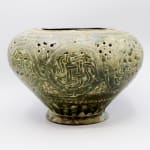Seljuk Incense Burner, Twelfth Century AD
Bronze
14.5 x 22.5 cm
5 3/4 x 8 7/8 in
5 3/4 x 8 7/8 in
CC.31
Further images
-
(View a larger image of thumbnail 1
)

-
(View a larger image of thumbnail 2
)

-
(View a larger image of thumbnail 3
)

-
(View a larger image of thumbnail 4
)

-
(View a larger image of thumbnail 5
)

-
(View a larger image of thumbnail 6
)

-
(View a larger image of thumbnail 7
)

-
(View a larger image of thumbnail 8
)

-
(View a larger image of thumbnail 9
)

-
(View a larger image of thumbnail 10
)

-
(View a larger image of thumbnail 11
)

The Seljuk Dynasty dominated an area from India to the Levant, during a brief period of military dominance in the Twelfth Century AD. The Empire was founded in 1034 by...
The Seljuk Dynasty dominated an area from India to the Levant, during a brief period of military dominance in the Twelfth Century AD. The Empire was founded in 1034 by Tughril, who ruled alongside his brother Chaghri and uncle Musa Yabghu. But the time of the Seljuks was to be brief; by the Twelfth Century AD, the Empire was in decline, and was supplanted by the Khwarazmian Empire in 1194. This short period of dominance, however, accompanied an artistic flourishing, especially in metalwork and in a form of pottery known as mina’i-bowls.
The skill and imagination of Seljuk metalworkers is evident in this remarkable bronze incense burner. The rim is decorated with small indented circles, followed by a ring of Arabic calligraphy in the kufic style, with artistically rendered but hard-to-read letterforms. The lattice is made up of roundels, encompassed by a serpentine interlocking design, and containing an intricate interweaving pattern. At the centre of each major design element is a raised bronze stud. Below the lattice is a curved meander pattern, made up of floral elements, above a fluted foot. On the base is a design made up of six triangles in a radiating arrangement. This piece is remarkable both for the quality of the casting, as well as the general lack of oxidation or damage.
This incense burner was likely owned by an elite household; guests at high society parties in Seljuk times were wafted with incense on arrival, perhaps to mask the less attractive smells of the city. The open fretwork would have allowed the scented smoke to escape. Incense was an expensive commodity, and it would have been important to the elite Seljuks to have a suitably resplendent vessel from which to use it.
References: similar incense burners can be found in Bamberg (University Museum of Islamic Arts BC 1975), New York (Metropolitan Museum 1975.314), Herat National Museum (01.18.56, 01.30.86a).
The skill and imagination of Seljuk metalworkers is evident in this remarkable bronze incense burner. The rim is decorated with small indented circles, followed by a ring of Arabic calligraphy in the kufic style, with artistically rendered but hard-to-read letterforms. The lattice is made up of roundels, encompassed by a serpentine interlocking design, and containing an intricate interweaving pattern. At the centre of each major design element is a raised bronze stud. Below the lattice is a curved meander pattern, made up of floral elements, above a fluted foot. On the base is a design made up of six triangles in a radiating arrangement. This piece is remarkable both for the quality of the casting, as well as the general lack of oxidation or damage.
This incense burner was likely owned by an elite household; guests at high society parties in Seljuk times were wafted with incense on arrival, perhaps to mask the less attractive smells of the city. The open fretwork would have allowed the scented smoke to escape. Incense was an expensive commodity, and it would have been important to the elite Seljuks to have a suitably resplendent vessel from which to use it.
References: similar incense burners can be found in Bamberg (University Museum of Islamic Arts BC 1975), New York (Metropolitan Museum 1975.314), Herat National Museum (01.18.56, 01.30.86a).










